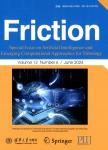Transfer of electrons on scratched iron surfaces:Photoelectron emission and X-ray photoelectron spectroscopy studies
Transfer of electrons on scratched iron surfaces:Photoelectron emission and X-ray photoelectron spectroscopy studies作者机构:Department of Materials ScienceIbaraki University Ashikaga Institute of Technology Institute of Mesotechnology
出 版 物:《Friction》 (摩擦(英文版))
年 卷 期:2018年第6卷第1期
页 面:98-115页
核心收录:
基 金:the Ministry of Education Culture Sports Science and Technology of Japan for supporting this work
主 题:thermally assisted photoelectron emission XPS real iron scratch-inducing environment Arrhenius activation energy environment molecule-surface hydroxyl group interaction
摘 要:We report the activation energy, ΔEa, for the quantum yield in thermally assisted photoelectron emission(TAPE) under 210-nm-wavelength light irradiation, and the associated X-ray photoelectron spectroscopy(XPS) results. Samples were cleaned only in acetone and scratched in air, water, methanol, ethanol, acetone, benzene, and cyclohexane. Glow curves, describing the temperature dependence of photoelectron emission(PE) quantum yield(emitted electrons/photon), Y, were obtained. A simple method of determining ΔEa using Y, called YGC, at seven temperatures up to 353 °C, for the same Y glow curve, was proposed. The ΔEa obtained using this method was almost the same as that obtained from Y for seven stationary temperatures(YST). For scratched samples, the TAPE was measured over two cycles of temperature increase and subsequent decrease(Up1, Down1 and Up2, Down2 scans) in the 25–339 °C range, and ΔE_a was obtained from YGC. The Arrhenius plot was approximated by a straight line, although a convex swelling peak appeared in the Up1 scan. ΔE_(aUp1) was in the 0.212–0.035 eV range, depending on the environment in which scratching was performed; ΔE_(aUp1) for water was much higher than that for acetone. This was explained in terms of the mode of the acid–base interaction between the liquid molecules and the hydroxyl group of Fe–OH. The values of ΔE_(aDown1), ΔEa Up2, and ΔE_(aDown2) were in the 0.038–0.012 eV range. The total count of electrons emitted during the Up1 and Up2 scans was found to decrease with increasing ΔE_(aUp1) and ΔE_(aUp2), respectively. ΔE_(aUp2) was found to increase with increasing presence of the FeO component in the analyzed Fe oxides. The convex swelling peak was attributed to the removal of carbon materials from the scratched surface and the effect of the increased electron density of the surface hydroxyl group of FeOH under the light irradiation.



